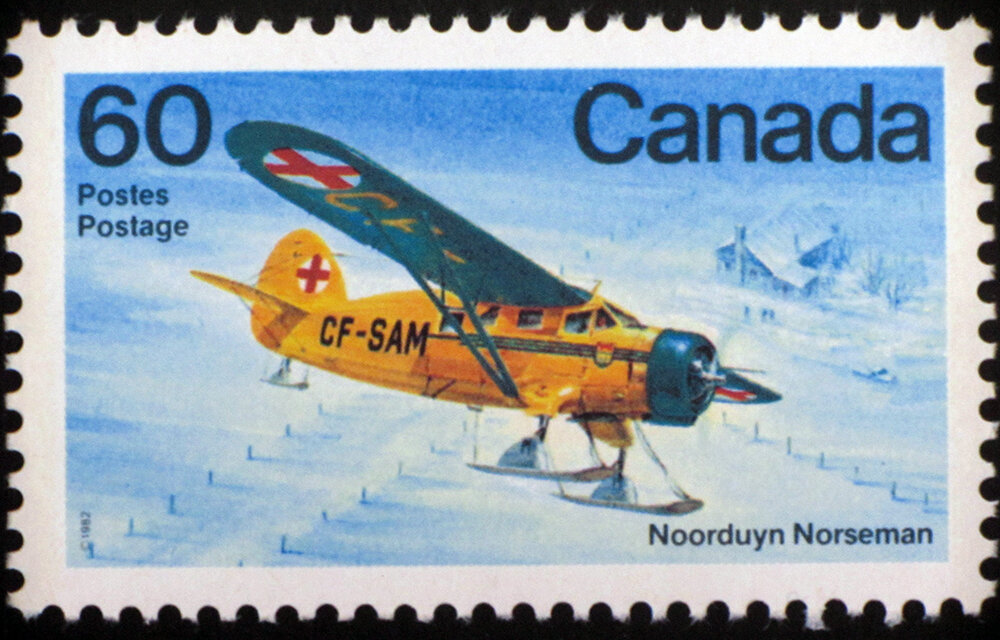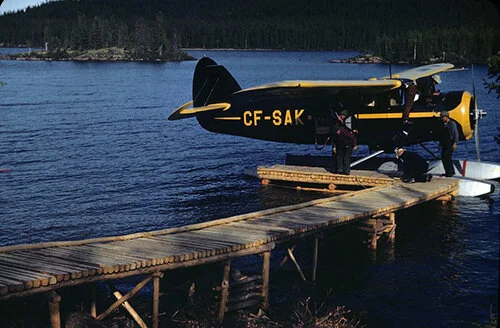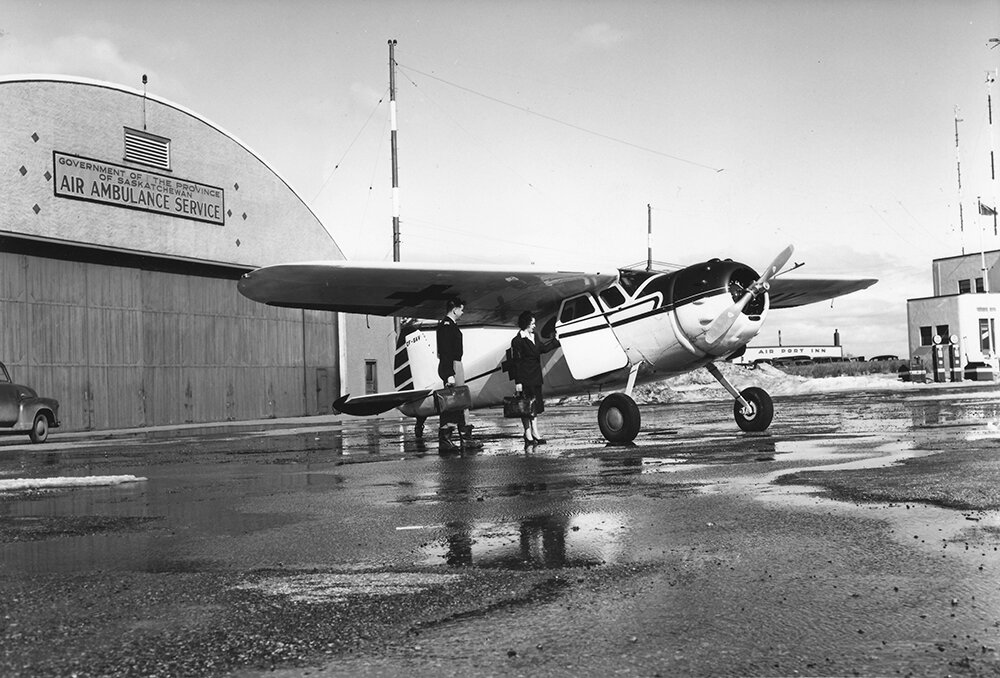Don Campbell and the Saskatchewan Air Ambulance
Folklore Magazine’s recent (Winter 2018 Edition) cover photograph of a Saskatchewan Air Ambulance aircraft is a reminder of a remarkable Saskatchewan success story.
The aircraft on the cover of Folklore Magazine (Winter 2018 Edition) is a Canadian-built Fairchild Husky purchased by the Saskatchewan Air Ambulance Service in the summer of 1947. Photographed in Regina, December 27, 1948 by Everett Baker. Photo courtesy of the Saskatchewan History & Folklore Society.
Could light aircraft and specially trained personnel be used to get the sick and injured from isolated farms and villages to hospitals in the province’s major cities? The Saskatchewan Air Ambulance Service has done this since 1946, carrying thousands to help – and still exists, if in modified form.
First, though, let us look back at Saskatchewan in 1945, after a ruinous depression and six years of war had dried up funds for medical infrastructure and highways. Hospitals and ambulance services outside the major cities were primitive and highways often closed by blizzards, rain or the spring thaw.
Into this situation came a new provincial government determined to improve health-care. So high a priority did it attach to this that the new premier, Tommy Douglas, took for himself the role of minister of public health. In this capacity, he was approached by air force veteran Keith Malcolm who pitched the idea of a well-equipped flying ambulance service.
D. Keith Malcolm in uniform standing in front of an air ambulance plane, 1949. Photo courtesy of the Provincial Archives of Saskatchewan, R-A2959.
Where Malcolm got this idea is unclear. Some sources say it was from talking during the war with Australian airmen familiar with their own country’s Flying Doctor Service. Others say it was inspired by air ambulance service operated from 1936 onward by Regina’s Speers Airways, a subsidiary of the ground ambulance service (and funeral home) of the same name). Speers’ chief pilot was Charlie Skinner, raised in North Dakota and the Willow Bunch area, and a barnstorming pilot before he joined Speers. So dedicated was Skinner that he moved with his wife into a tiny house at the Regina airport so he could respond faster to calls for help.
Speers’ air ambulance was widely publicized -- it is inconceivable that Douglas and other government ministers did not know of its existence and success.
Whatever the spark for this idea, the Saskatchewan Department of Public Health acquired a surplus RCAF Norseman utility plane in the autumn of 1945. It also hired a nurse (Mabel Gleadow) and an air maintenance engineer (Donald Watson) to help pilot Malcolm. They took off from Regina on their first ambulance flight on February 2, 1946, to the village of Liberty, 100 kms northwest of the capital, to pick up a woman variously described as suffering from appendicitis or being in a diabetic coma. Sadly, she died.
But the idea caught on. The service became so busy that a second Norseman and pilot (Julien Audette) was added that summer. By the end of the service’s first year of operation, 409 patients had been carried. The government calculated the cost of each flight worked out to $364, with $25 paid by the patient, a ratio was that updated over the coming decades.
Issued in the early 1980s, this Canada Post stamp saluted the Saskatchewan Air Ambulance service and, in particular, one of its early aircraft, Canadian-built Noorduyn Norseman CF-SAM, which has been preserved in the Moose Jaw branch of the Western Development Museum. Illustration: Canada Post.
The service’s two aircraft got a true workout during the epic blizzards of January and February 1947, which went on for several weeks. “We just flew from dawn until dark…and then after that,” remembered pilot Julien Audette, a wartime RCAF transport pilot.
Norseman on Wollaston Lake, June 1946. This plane was not part of the Air Ambulance Service, which was responsible for the southern half of the province. Rather, it was used (along with other planes) by Saskatchewan Government Airways to provide ambulance services in northern Saskatchewan. Photo courtesy of the Saskatchewan History & Folklore Society, Everett Baker Photo Collection.
The aircraft on the cover of Folklore is a Canadian-built Fairchild Husky purchased in the summer of 1947 to replace the older Norseman aircraft. Alas, the Husky was badly damaged on its delivery flight. Even after it was repaired, the Husky flew strangely and creaked ominously, said air ambulance pilot Don Campbell, hired in late 1948. Like Malcolm and Audette, he had been a wartime RCAF flying Instructor, then ferried Lancaster bombers to the UK, and finally had been picked to attend the Empire Central Flying School.
The battered Fairchild Husky was sold in the summer of 1950. Soon, the air ambulance service had standardized on the Cessna 195 -- cramped, but also tough and reliable. Its landing gear, made from sprung steel, easily handled rough landings in fields and pastures.
The backbone of the Saskatchewan Air Ambulance service in the 1950s and 1960s was the tough little Cessna 195, one example of which is shown at the Regina Airport in March, 1952. Photo: Government of Saskatchewan.
Pregnancy, heart attack, stroke, injuries from farmer or hunting accidents -- the air ambulance handled them all. September 1948 brought the first birth of a baby on a service aircraft. For many years in the 1950s, calls to help children fighting polio dominated the service’s work, though farm and auto mishaps came close to rivalling it.
To provide better care, service nurse Irene Sutherland became the first registered nurse to attend the RCAF’s Institute of Aviation Medicine in Toronto, studying on the effect on patients of decreased air pressures, turbulent flight conditions and other reactions brought on by flight in small, unpressurized airplanes. That allowed her to produce a manual for the service’s flight nurses, who were responsible for the care of the patient en route, maintenance of all medical equipment and supplies, sanitation of the aircraft cabin, and recording patient history and flight experience.
Don Campbell, chief pilot and director of the Saskatchewan Air Ambulance service, with senior flight nurse Irene Sutherland in 1956. A plaque installed by the SHFS near Sutherland’s hometown of Assiniboia salutes her dedication and skill. Photo: Government of Saskatchewan.
As Campbell relates in his 1993 autobiography, Wings of Mercy, when a request to pick up a patient arrived (from a responsible citizen like a doctor, municipal council or RCMP member), the air ambulance staff would put this simple question to the caller: could a vehicle, in a high gear, drive at 40 mph along that field? And could the caller have somebody start a small fire to indicate the direction of the wind? What was the direction and distance to the nearest town? And what did the farm buildings look like?
A few mishaps damaged aircraft over the years, but the air ambulance service takes immense pride in the fact it had never lost a passenger or crew member in a crash.
Campbell and flight nurse Irene Sutherland were headed for Estevan one day in the mid-1950s when they ran into a flock of migrating ducks that refused to get out of their way. They dodged most of them, but one came through the propeller arc, decapitated itself and punched a saucer-sized hole in the windshield in front of the sleeping Sutherland. “A piece of plexiglass cut me in the hand. It went back and hit her in the face. The duck then landed in the back part of the plane.” To Campbell’s horror, Sutherland was drenched in blood. “But it turned out it was just the innards of the duck. She cleaned herself up as best she could and that’s when she realized she wasn’t hurt. I think that if she would have seen herself, she would have died!
“Needless to say, we came back. We picked up another airplane and went back and finished the trip,” said Campbell, who always praised the work of the service’s flight nurses, pilots and maintenance personnel.
As Campbell says in his book, there initially was high turnover among personnel because the CCF government kept staffing and wages low. Highly qualified pilots – with instrument and night ratings – were paid at the same rate as STC bus drivers, he noted, a tad sourly.
A base at Saskatoon was opened -- and closed twice because of a shortage of staff. Its absence meant that Regina-based crews spent long hours flying across the province. Friction grew until chief pilot Malcolm resigned in the summer of 1951. He eventually was replaced by Campbell.
To handle long-range flights (the Mayo Clinic in Rochester, Minnesota, was a frequent destination) the service acquired a twin-engine Cessna Crane, then a succession of Beech 18s.
This twin-engine Beech 18 of the Saskatchewan Air Ambulance was used to ferry patients over long distances that could not be handled by the smaller Cessna 195. This one, CF-FVB, had an engine disintegrate in flight over Manitoba in the mid- 1950s but stayed together long enough for a safe landing. Photo: Government of Saskatchewan.
At least twice, the service mulled using helicopters. In 1951, Britain’s Bristol Aviation offered to bring an air ambulance version of its latest product, the Sycamore helicopter to Regina, for a demonstration, but this machine apparently never arrived. Thirty years later, the then-president of Saskatchewan Government Insurance, Don Black, judged that the Crown corporation had a good financial year and suggested acquiring a pair of state-of-the-art Bell JetRanger helicopters for the air ambulance service, basing them in Regina and Saskatoon. The provincial Department of Government Services, which had taken over the management of the service’s aircraft in 1966, declined the offer, citing the high operating and maintenance costs.
Campbell, convinced that the government of the day was converting the air ambulance service into an on-call executive air transport unit, left government service at the end of 1967 to become the manager of the city-owned Regina Airport.
It had been in his post-Air Ambulance years that I met Campbell when I went to get his permission to photograph a rare aircraft on the apron at the Regina airport. He was a little gruff, but softened as the schoolboy photographer before him presented his case. Over the years, I interviewed him several times and also arranged for him to speak about his beloved air ambulance service to local aviation historians.
Campbell was leery of helicopters for this work. Far better, he told me in the 1990s, to use robust light aircraft, like the DHC Beaver or Turbo-Beaver, that could land at any of the many small-town airports built in the 1950s or 1960s, or even on a highway.
So, what would he think of things today? STARS (the Shock-Trauma Air Rescue Service) since 2012 has used a pair of helicopters with highly trained medical staff to bring patients to major trauma centres. The Saskatchewan Air Ambulance Service remains in existence, flying a handful of fixed-wing aircraft to carry patients at speeds and over distances that helicopters cannot match.
Alas, we shall never know. Campbell, so long and so closely identified with the success of Saskatchewan’s aeromedical experiment, died in 2001. Moments after his funeral, an air ambulance aircraft, its turboprop engines howling mournfully, flew over the cemetery in a salute.
Will Chabun. Portrait by Don Healy.
Will Chabun is a recently retired Regina journalist who is a long-time member of both the SHFS and the Regina chapter of the Canadian Aviation Historical Society.
“people stories” shares articles from Folklore Magazine, a publication of the Saskatchewan History & Folklore Society. Four issues per year for only $25.00! Click below to learn more about the Magazine and to find out how to get your story into the blog!
A note on sources:
“Wings of Mercy”, by Will Chabun, the Leader-Post, Sept. 30, 1978.
Wings of Mercy – A Story of the Saskatchewan Air Ambulance by Donald N. Campbell, Turner-Warwick Publications, 1993.
The Saskatchewan Air Ambulance Service: Medical and Public Health Aspects, remarks by Milton Roemer, MD, director, Medical and Health Services, Saskatchewan Department of Public Health, to Department of Transport Approved Civil Aviation Medical Examiners, RCAF Institute of Aviation Medicine, Toronto, 9 March 1956.








